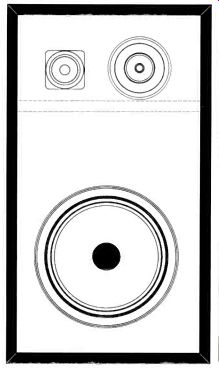
The world's fastest bookshelf speaker.
That's not a joke. The new Rectilinear X is at least four times faster off the line than its closest competition. And you're not reading a drag-racing magazine.
But let's begin at the beginning.
A few months ago, we announced the Rectilinear X (that's a ten, not an ex) as the world's first high-fidelity loudspeaker. We explained that it was the first speaker system to pass a signal more or less unaltered, in the same sense as a minimally acceptable amplifier. (We didn't say, as a few people seemed to interpret us, that our new $199 bookshelf speaker made all costlier systems obsolete. There will probably always be a need for larger, more expensive speakers for reasons of power, efficiency, versatility, special acoustical problems, etc. But not accuracy.) What we want to point out in this ad is the specific reason for the superior accuracy of the Rectilinear X as a listening device.
Not the frequency response, although it happens to be beautifully flat and smooth. Nor the absence of harmonic distortion, although the 10-inch woofer with its one-inch linear travel won't distort a 50 Hz signal at 10 watts any more than a medium-priced stereo receiver. Nor even the transient response, although the exceptionally low-mass tweeter follows steep wave fronts with great alacrity.
No. The truth is that all of today's top speakers have reasonably smooth frequency response, low harmonic distortion and good transient response.
And it would be utterly impossible to predict their individual sound quality or their relative ranking from these data alone.
However, as we have discovered, there is a measurable quantity that corresponds very closely to audible differences in speaker performance. Time delay distortion.
In our introductory advertising, we referred to this much-neglected criterion by the more specialized mathematical term of envelope delay distortion, a concept with many ramifications in network theory. A sophisticated explanation would require a very involved discussion of loudspeaker phase response as distinct from amplitude response, but the basic idea is quite simple.
Sound waves travel through air at the rate of approximately 1135 feet per second (at room temperature). Therefore, if you're sitting let us say 11 1/3 feet from a speaker, you'd expect a signal to reach your ear one one-hundredth of a second (10 milliseconds) after the amplifier feeds it to the speaker terminals.
Not so. It will reach your ear more slowly.
It seems that speakers don't speak the instant they receive a command from the amplifier. Between the entry of the electrical signal and the exit of sound, there's a time delay. Not just a slowdown of the rate at which pressure amplitude builds up (i. e., transient response), but an actual moment of silence. Dead silence.
What's more, the length of this moment is frequency dependent. Generally speaking, lower frequencies are delayed longer than higher frequencies. Which means that the low and high frequency components of a signal that enter a speaker at the same instant don't arrive at your ear at the same instant. There's a smearing effect. This accounts, in part, for the gutsy, canned sound of some popular speakers, which many people like although its bears no resemblance to live music.
Now, time delay distortion is least audible at low frequencies' and becomes more and more obvious going up into the midrange. Woofers, with their massive moving parts and complex networks, are the worst offenders, so it becomes important to keep them out of the midrange. The only speaker system that goes all the, way in this respect is the Rectilinear X. Although the specially designed 10-inch woofer has remarkably little time delay to begin with, it's crossed over at 100 Hz to a 5-inch midrange driver with phenomenally low time delay distortion. Thus the entire mid-frequency band has the benefit of minimum time delay. And you can hear it.
At 500 Hz, for example, the Rectilinear X has a time delay of less than 0.2 millisecond. By comparison, the top-of-the-line model of the most famous name in bookshelf speakers has a delay of approximately 0.8 millisecond at the same frequency, mainly because most of the output is still coming from the woofer. The Rectilinear X is literally faster off the start line.
Since no other speaker system cuts off the woofer at 100 Hz, and no moving-coil speaker is faster in the lower midrange than our 5-inch driver, the Rectilinear X is the world's speed king At which point we can't resist borrowing a phrase from the underground.
"Speed kills." Our competition.
(For further information, see your audio dealer or write directly to Rectilinear Research Corporation, 30 Main Street, Brooklyn, N. Y. 11201.)
Rectilinear X
--------
(Audio magazine, 11/1969)
Also see:
Astrocom/Marlux Model 407 tape deck
= = = =